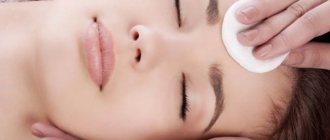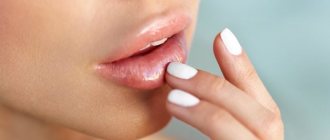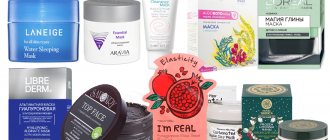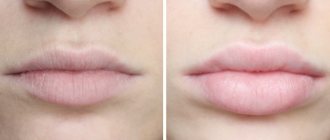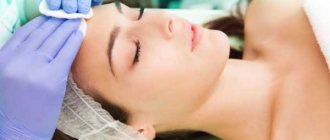Hyaluronic acid is a valuable component of our skin, which acts as a hydrofix. She, like a sponge, absorbs moisture and holds it inside. This is necessary for youth, elasticity, smoothness of the skin. Otherwise, it would dry out and turn into an apricot.
Having discovered the irreplaceable properties of hyaluronic acid, humanity has learned to synthesize it. And they rushed to “stuff” her facial skin from the outside (cosmetics) and from the inside (injections).
But do we need it? Does such a substitute for our own hyaluronic acid work? And if this is not a dummy, then what does hyaluronic acid actually do for the skin - benefit or harm?
Let's understand the true meaning of what beauty marketers use to create a sensation.
What is hyaluronic acid?
Queen of cosmetology, elixir of youth, perfect moisturizer, living water - what epithets have been given to hyaluronic acid! It is added to skin care products, decorative cosmetics, and even injected invasively into the dermis to smooth out wrinkles, tighten oval shapes, and add volume to lips, cheekbones, and chin.
But what is it really - a magical savior or a placebo?
First things first.
Hyaluronic acid (hyaluronate, hyaluronan) is found in our body, including in the skin, fluids (tears and saliva), joints, and connective tissue.
Now we are only interested in the skin, so let's see how everything works here.
Following the outer layer of skin (epidermis) is a supporting layer - the dermis. The cells of the dermis are connected into a single structure by the intercellular matrix - a kind of cellular “glue”. It is based on collagen, elastin and hyaluronic acid. The age-related changes in our face depend on the state of the cellular matrix.
Hyaluronic acid in this design is a moist environment in which the collagen-elastin framework is immersed. It is a kind of gel and accumulates water, nutrients, microelements - everything that comes from the capillaries and is sent to the cells.
Our skin tends to lose moisture. Through pores we lose up to half a liter of fluid per day. And it is hyaluronic acid that prevents our face from turning into “dried fruit”. It retains moisture in the dermis in the form of a kind of gel.
The hyaluronic acid molecule is large. It can attract and hold in the intercellular space an amount of water that exceeds its own weight hundreds of times.
The main tasks of hyaluronate are to moisturize the skin and protect against toxins.
How else can you use hyaluronic acid for your face at home?
For easier penetration of hyaluronate into the layers of the skin, it is advisable to use additional products. They will be a kind of conductors and stimulators of the process. What kind of means are these? These are a mesoscooter and alginant masks.
Alginate mask
Alginates are widely used in the manufacture of cosmetics. Brown algae is a source of these substances. They help activate collagen production, restore the skin, and cleanse it well of impurities and dead particles.
With the help of alginate products, swelling disappears and the functioning of the sebaceous glands is normalized. Compositions made with alginates are plasticizing. A thick mask appears on the skin. It's easy to remove.
What to take:
- two milliliters of gel (or HA);
- 30 grams of alginate powder;
- 90 grams of water to dissolve the alginate;
Next, you need to perform the following steps: First, remove makeup, dust and dirt from your face. Apply cream to eyelashes and eyebrows. It should be fat. This must be done so that the hairs, during the process of plasticizing the mask, do not stick to it. Hyaluronic gel is applied to the skin.
Pour alginate powder into water and mix slowly. The resulting mass should have the consistency of sour cream.
The resulting composition is applied to the face with a spatula, avoiding the area around the mouth and eyes.
Don't be alarmed if you experience any pressing sensations. Then advice: spread the contours of the mask with cream. This is done to easily remove the edges of the mask from the skin of the face, and so that there is no feeling of pain.
After 25 minutes, remove the mask. You need to start from the chin. Lubricate your face with caring cream.
Important! You should try to quickly apply the mask to your face, as quickly as possible, because the product hardens within a few minutes.
Hyaluronic acid tablets
Why does the content of hyaluronic acid in the skin decrease?
The fun begins with this question.
Cosmetologists and cosmetics manufacturers impose on consumers the idea that with age, the amount of hyaluronic acid in the skin decreases critically. Allegedly, up to a certain point there is enough of it, and then it begins to be sorely lacking. The “point of no return” is called differently: 18, 20, 25, 30 years. The promotion of all cosmetics and injections based on hyaluronic acid is based on this myth.
In fact, everything is different. The amount of hyaluronic acid in the body remains almost unchanged. The human body consists of 0.007% hyaluronate. For a woman weighing 60 kg, this is approximately 13 grams.
Hyaluronic acid is a regularly renewed, but not disappearing component. About 5 grams of hyaluronic acid are broken down and synthesized per day.
So its molecules are ready to work in full force even after 30, 40, 50, etc. years.
The problem comes from the other side, from within. The required amount of moisture simply does not reach the hyaluronic acid; the capillaries do not carry it. There's nothing to hold on to.
The fact of the matter is that our skin NEEDS its own hyaluronate to remain young and elastic. No need to add new hyaluronic acid.
What then is needed? Add moisture, raise all the “barriers” on its way to the cells.
To do this, we restore skin microcirculation, free blood vessels from the “shackles” of spasmodic muscles, and improve trophism (nutrition) of cells. This is what the participants of the “Flourish” marathon from MelAnnett do. Join us!
Contraindications
Despite very flattering reviews, hyaluronic acid still has certain contraindications. By using a cream with this component, you are essentially trying to intervene and correct the natural processes of the body. He, in turn, can give you responses.
A severe allergic reaction can occur to the hyaluronic component, which is of animal origin. In addition, the effect of such a remedy is very weak.
Do not use acid-based cream:
- For serious autoimmune diseases
- During pregnancy and lactation
- In case of exacerbation of infectious diseases
- If there are serious injuries to the skin: burns, deep cuts, etc.
- If you have problems with blood clotting
- During the recovery period after deep peeling using acids, after the laser resurfacing procedure
It is not recommended to use this product for more than three months. This can cause natural lymphatic drainage to slow down. In addition, hyaluric acid is not compatible with products that contain AHA acids. In this case, there will be no effect at all, because these substances simply neutralize each other’s actions.
Origin of hyaluronic acid
Humanity learned about the existence of hyaluronic acid less than a century ago.
It was first isolated in the 30s of the 20th century by biochemists Carl Meyer and John Palmer. They discovered an unusual polysaccharide in the vitreous humor of the bovine eye. Later they came up with a name for it. It comes from the Greek root hyalos, meaning “glassy.”
It took several decades to determine the structure and properties of hyaluronic acid.
And, of course, scientists rushed to look for ways to synthesize it. It was found that hyaluronate is obtained from various organs of mammals, as well as from microorganisms (hemolytic streptococcus, streptomycetes, corynebacteria). A number of methods have become industrialized, especially the production of hyaluronate from chicken combs.
And hyaluronic acid is still produced on an industrial scale in two ways:
- Extraction from mammalian tissues: chicken combs, umbilical cords of newborns.
- Microbial method based on producing bacteria: Streptococcus, Pasteurella.
Initially, synthesized hyaluronic acid was used in ophthalmic operations (since the 70s), and then they went further. The substance began to be used in gynecology, dermatology, surgery, traumatology, and orthopedics.
For 20-30 years now, hyaluronic acid has been a “triumphant” in cosmetology and the cosmetics industry.
Microbial synthesis of hyaluronate is in high demand. The price for 1 kg of purified imported product based on animal raw materials is 700 million rubles (data for 2022).
But is the game worth the candle?
The effectiveness of hyaluronic acid for facial skin
Let's not keep the intrigue and say right away that neither injections nor care products with hyaluronic acid saturate the skin with moisture.
How do products containing hyaluronic acid actually work?
- Injections of fillers (fillers) based on hyaluronic acid.
They “push apart” and stretch the tissues, creating an artificial load on them in the form of a gel. The skin is not moisturized, but becomes swollen.Instead of treating dehydration, fillers make the problem worse. The supply of moisture to the skin through the capillaries only becomes more complicated, not simplified: the channels are blocked by the aggressor dermal filler, water is in short supply. And what will happen when all the moisture is drawn out by a shock dose of artificially introduced hyaluronic acid? Other, deeper layers of the skin will suffer and dry out.
In addition, an unusually large dose of hyaluronic acid provokes increased production of an enzyme that destroys it. Therefore, a person’s own hyaluronate can be more actively destroyed.
Don’t forget that the filler will dissolve in a few months, and the skin stretched by it will become flabby and sink into deeper wrinkles.
- Skin care cosmetics with hyaluronic acid.
What effect do the manufacturers promise:- nourishes the skin with moisture (penetrates deep into the dermis and attracts water molecules),
increases skin elasticity,
- smooths out wrinkles,
- gives a lifting effect,
- eliminates irritation,
- keeps the appearance of acne under control,
- promotes wound healing,
- resists the damaging effects of UV radiation.
Which of this is true and which is deception? We analyze in detail two types of hyaluronate, which are added to cosmetics, and draw conclusions.
Indications
The best age to start laser hyaluroplasty is 35 years.
Over the next 20 years, regular implementation of these procedures will help keep the skin young, healthy, tightened and moisturized, prevent, correct and neutralize the aging process. Main indications of the procedure:
- dryness, thinning, tightness and increased sensitivity of the skin,
- multiple small wrinkles and medium wrinkles,
- decrease in turgor,
- drooping, decreased elasticity and firmness,
- skin restoration after laser resurfacing, Fraxel procedures, peelings,
- prevention and treatment of photoaging,
- unhealthy skin color due to insomnia, overwork.
Types of hyaluronic acid
Depending on the size of the molecule, hyaluronic acid in cosmetics can be high molecular weight or low molecular weight. Two different products, two different marketing concepts. Let’s understand both so as not to fall for the bait of cosmetic brand marketers with their eloquent promises that are not always justified.
- High molecular weight hyaluronic acid (HM-HA)
It consists of large molecules that are unable to penetrate deep into the skin. That is, its synthesized analogue does not exactly reach the dermis - the main “residence” of our genuine hyaluronic acid.This does not mean that such hyaluronic acid is completely useless. It is distributed throughout the skin, embedding itself in our own water-fat layer. That is, all it can do is complement our protective barrier and prevent the evaporation of moisture from the skin.
It is also believed that by covering the epidermis, hyaluronic acid attracts moisture from the air. But even if this is so, how much do we need this additional water if it does not get inside?
In addition, the reverse process is possible. If there is not enough moisture in the air, the hyaluronic “film” on the skin will begin to draw water from the epidermis, drying out the skin.
- Low molecular weight hyaluronic acid (LM-HA)
Cosmetics manufacturers sat down and thought. Since a large molecule does not penetrate the skin, what should be done? Add hyaluronic acid with a smaller molecule size to the cosmetic product. This should result in a more effective product. A small molecule will climb deep into the dermis and remain there, working like a magnet for moisture.But this path turned out to be an unsubstantiated theory, empty big words. How does NM-HA actually work on the skin?
There are NO scientific studies that would confirm its deep penetration into the dermis and stimulation of fibroblasts. This is “proven” only at the level of statements made by manufacturers of cosmetics with NM-HA from the category “the product smoothed out wrinkles in women after 2 months of daily use.” You know those “studies”: the subjects’ wrinkles are smoothed out, but the customers’ wrinkles are not?
And even if at some point scientists do find out that NM-HA reaches the dermis, it is not known whether this is good or whether the skin needs it.
is it so bad? There is still one argument in favor of NM-GK (although it is somewhat inconclusive). It has been proven that such a molecule penetrates the upper layer of the skin - the epidermis. And here, too, there is its own hyaluronic acid, it is synthesized by the main cells of the epidermis - keratinocytes. And external use of NM-HA activates keratinocytes - this has been confirmed. It’s just not yet clear whether this somehow affects the synthesis of one’s own hyaluronic acid or not.
In general, there are continuous ambiguities that strongly contrast with the confidence of brands that their hyaluronic acid will rejuvenate everyone and make them beautiful.
And one more nuance. Unlike large hyaluronate molecules, small ones do not work to strengthen the water-fat layer of the skin.
What else can be said about the two types of hyaluronic acid? Fillers, as a rule, contain its high molecular weight version. Both types are included in cosmetic products (separately or together). In so-called “active” cosmetics (serums, masks), the emphasis is on low molecular weight hyaluronic acid.
This is interesting!
Scientists have discovered that young skin has more large hyaluronic acid molecules, while skin with accumulated photodamage has more small ones.
Hyaluronic acid injections for the face: pros and cons
Many representatives of the fair sex know about the amazing effect hyaluronic acid has on the face.
Also, there is widespread information that injecting HA subcutaneously is a more effective method than applying it externally.
Of course, injections will cost more. In addition, one procedure cannot be done here. You will have to carry out several manipulations by injecting “gailuronka” under the skin. This is not to say that the product should not be trusted.
It is believed that the “disadvantages” of this procedure are:
- doctor without proper experience:
- the degree of sensitivity to the procedure itself is very high;
- it is possible that an infection may occur.
These factors can create a painful situation. This, in turn, will force the patient to stop using the drug, but there should be several procedures. These disadvantages are also typical for other similar methods of mesotherapy, and not only apply to “hyaluronic acid”.
Attention! If the facial gel contains the same components that are contained in the injection, it is better to choose it. It will be safer this way.
Despite the possible negative consequences, there is a category of women who prefer the injection method. In this case, hyaluronic acid is injected into the skin of the face around the eyes, into the lips, and into different areas.
Women are satisfied with the results obtained and happily proceed to the next procedures. The “plus” in this situation is that scars or cicatrices will not appear.
If the procedure was completed in a hurry, then after 3 or 5 days, the patient can boast of her attractive “new” appearance.
External and subcutaneous administration of hyaluronic acid, as processes, have fundamental distinctive features if you carefully consider them.
- If hyaluronic acid is used externally, the HA molecule does not penetrate the layers of the dermis. But it forms a protective mesh layer on the skin. The skin will not dry out, become chapped or be subject to other negative influences.
- If an injection is used, moisture begins to be attracted to the acid molecules and retained for a long time. Then you will see an excellent result. A woman's face will shine with beauty.
Can hyaluronic acid be harmful?
Hyaluronic acid in cosmetics and dermal fillers is promoted as a safe product that is similar to our skin.
Is it really?
- Cosmetics with hyaluronic acid
may cause negative reactions in the skin.- As numerous studies have proven, hyaluronate provokes inflammation in tissues
. This applies to the same low-molecular form, which penetrates deeper into the skin and is supposedly more effective. - Allergy
. It has been scientifically proven that hyaluronic acid causes allergic reactions. Even if your cream is labeled “hypoallergenic,” try it first behind the ear or on the neck. The test will show whether the product suits you or not. - The permissible concentration of hyaluronic acid in cosmetics is up to 1% (sometimes 1.5-2% is allowed). Nothing bothers you? If this is such a useful thing, “living water”, an extremely beneficial and skin-related component, why can’t it be added to creams in more impressive quantities? To avoid harm? This alone should alert you and make you think.
- Fillers based on hyaluronic acid are definitely dangerous
. You can read about it hereIn short, they are:
- They cause a lot of side effects and complications:
terrible swelling, hematomas, bumps, inflammation, infection. There are also more severe cases: tissue necrosis, vascular obstruction, nerve paralysis, blindness.
They are allergens
. Cosmetologists are silent about this and even talk about the hypoallergenicity of preparations based on hyaluronic acid. But scientific research confirms that an allergic reaction can develop within a few minutes/hours/days/months. The severity varies - from redness, swelling and persistent nodules to anaphylaxis and Quincke's edema. - They cause a lot of side effects and complications:
- They can cause diseases: pharyngitis, laryngitis, sore throat, otitis media, pneumonia, rheumatism,
etc. Hyaluronic filler is synthesized from streptococci, so it retains the genetic material of bacteria. After injections, this “time bomb” settles in the body for many years. Microorganisms can become active soon after the procedure, or after 5 or 10 years. Typical diseases will appear. - Cause aesthetic defects
. Fillers often migrate from the target area to neighboring areas. I pumped up my lips, and you “grew” a “hyaluronic mustache” above them, and instead of your upper lip a “proboscis” appeared. Or I injected filler into the chin to improve the contour, but ended up with extra volume under the lower jaw, a double chin.
List of effective creams
There are many ointments with hyaluronic acid sold in pharmacies. Some recommend using the Fillerina line of products - a complex made in Switzerland, containing 6 types of hyaluronic acid. Others advise purchasing L'Oreal Paris RevitaLift or Radevit cream. But the names of the drugs alone don’t say anything, so let’s look at the most popular ones in more detail.
Composition and instructions for use of Sebozol shampoo
Gel Curiosin
The cosmetic product is sold in the form of a gel. The product is used to treat acne and inflammatory diseases of the skin. The active component is hyaluronic acid.
The principle of action of Curiosin against wrinkles:
- Hyaluronic acid binds to liquid, filling the wrinkle from the inside.
- The product helps normalize metabolism, improves blood circulation in the skin, and stimulates the production of its own collagen.
- Additional substances in the composition have anti-inflammatory and healing effects, ensuring rapid restoration of the epidermis.
Expected effect from use: leveling out fine wrinkles, deeply moisturizing the skin, stopping the inflammatory process, narrowing pores. The method of application is quite simple: apply the product to dry and cleansed skin. Frequency – 1-2 times a day.
Possible side effects:
- Redness at the application sites (a side effect due to a rush of blood);
- Excessive dry skin;
- Allergic reaction (itching, burning, angioedema).
No overdose has been reported. Use during pregnancy and lactation is not recommended, since clinical studies on the safety of the drug have not been conducted. The price is 8-9$.
Heparin ointment
The composition contains: heparin, benzocaine, soft paracin, glycerin, sterile water, stearic acid, sunflower oil. The active ingredient is heparin. This substance helps thin the blood and prevents the formation of blood clots. It also relieves swelling as it improves the permeability of blood vessels. Heparin ointment has an anti-inflammatory effect.
How does ointment affect the condition of the skin? Many women, waking up in the morning, observe swelling of the eyelids, dark circles under the eyes, and puffiness of the face. In most paintings, this is a consequence of an incorrect lifestyle - bad eating habits, non-compliance with the drinking regime. The swelling goes away by lunchtime, and wrinkles appear in their place.
Heparin fights precisely such wrinkles, relieves puffiness, eliminates bags under the eyes, and improves skin condition. The ointment is quickly absorbed, does not cause a sticky feeling, and works at the level of blood vessels. Can be applied to sensitive skin around the eyes. Cosmetologists note that heparin ointment helps well against spider veins, but only with prolonged use.
Worth knowing: Heparin ointment is recommended to be used only on days when swelling and dark circles appear under the eyes. Apply to clean skin, including the area around the eyes. Leave for 20 minutes, after which you can use a regular cosmetic cream. The ointment is used up to 3 times a week.
Heparin ointment against facial and deep wrinkles is an ineffective remedy; it does not help to cope with the problem; it is better to pay attention to other creams.
Ointment Radevit
A combined drug with regenerative and anti-inflammatory properties. The product enhances the protective functions of the skin, helps normalize the processes of keratinization of the skin, moisturizes and softens the skin. The drug is used to treat many skin diseases; it does not contain hormonal substances, which allows use regardless of medical history.
Instructions for the use of Taktivin injections and analogues
The product helps get rid of wrinkles. To do this, you need to apply the cream 1-2 times a day. To achieve the desired effect, Radevit must be used for a long period of time - at least one month.
Contraindications:
- Hypersensitivity to the components of the drug.
- Excess retinol in the body.
There are no side effects. When using the cream against the background of an acute form of the inflammatory process, the following negative phenomena are possible: hyperemia of the skin, increased swelling, and development of pain. Reviews of Radevit ointment are positive and negative - some women praise the drug, others did not notice any results.
Gel Pectilift
This product is recommended for the care of mature skin. To get rid of wrinkles, the cream is applied to the skin of the face in a thin layer. Frequency of application – once a day. After 15 minutes, the product is washed off with running water, and a moisturizing gel is applied. Duration of use is two weeks, after which they take a break.
Effects of using Pectilift gel:
- Evens out shallow wrinkles, improves the condition of the skin;
- Tightens the facial contour, tones;
- Strengthens the synthesis of its own collagen and hyaluronic acid;
- Reduces the pathological activity of the sebaceous glands, narrows pores;
- Accelerates the process of renewal of the upper layers of the epidermis;
- Accelerates the process of exfoliation of “dead” skin particles;
- Stops the inflammatory process;
- Protects skin from adverse environmental influences.
Please note: Pectilift gel is easy to apply and quickly absorbed; it contains no preservatives, flavors, fragrances, or hormonal substances. The drug does not lead to the development of negative effects, there are no contraindications.
Mostly there are favorable reviews. It is noted that the gel smooths out wrinkles, improves complexion, and makes the skin younger. The positive effect is observed after several applications and lasts for a fairly long period of time.
Facial cosmetics with hyaluronic acid
- Serums.
They contain a high concentration of the active substance, with a minimum of additives and, as a rule, without fat fractions. They usually contain low molecular weight hyaluronic acid, which acts at a deeper level. We talked above about the ambiguity and unproven effectiveness of such hyaluronic acid. - Creams.
They usually add “large-caliber” hyaluronic acid, which works on the surface of the skin. It attracts moisture either from the air (“+”) or from the epidermis (“-”). - Masks.
As a rule, they contain a “loading dose” of hyaluronic acid – 1% (the maximum allowable percentage). They may contain both types of acid. It is recommended to use masks 1-2 times a week and after exposure to negative factors (sun, snowstorm, sea water). - Gels and emulsions.
They have a light texture. Recommended for use for oily and problem skin, as well as in hot weather. - Pure Hyaluronic Acid Powder.
Mixes with water and forms a gel. You can add it to cosmetics or prepare your own skincare products based on it.
General Tips
In order not to repeat the same thing in recipes, we have highlighted the following basic recommendations.
- Before applying masks, be sure to thoroughly cleanse your facial skin of cosmetics and daily impurities.
- Leave the compositions on the skin for at least 20 minutes, then wash them off with soft water (filtered or boiled) at room temperature.
- Prepare a quantity of composition that is enough for 1 use.
- Before applying each new mask to your facial skin, be sure to do an allergic reaction test.
- Avoid applying masks to the areas around the eyes and lips.
